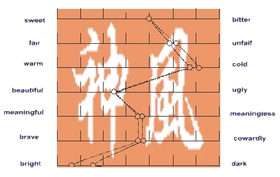Semantic differential
| Semantic differential | |
|---|---|
| Diagnostics | |
 Fig. 1. Modern Japanese version of the Semantic Differential. The Kanji characters in background stand for "God" and "Wind" respectively, with the compound reading "Kamikaze". (Adapted from Dimensions of Meaning. Visual Statistics Illustrated at VisualStatistics.net.) | |
| MeSH | D012659 |
Semantic differential is a type of a rating scale designed to measure the connotative meaning of objects, events, and concepts. The connotations are used to derive the attitude towards the given object, event or concept.
Osgood's semantic differential was an application of his more general attempt to measure the semantics or meaning of words, particularly adjectives, and their referent concepts. The respondent is asked to choose where his or her position lies, on a scale between two polar adjectives (for example: "Adequate-Inadequate", "Good-Evil" or "Valuable-Worthless"). Semantic differentials can be used to measure opinions, attitudes and values on a psychometrically controlled scale.
Theoretical background
Nominalists and realists
Theoretical underpinnings of Charles E. Osgood's semantic differential have roots in the medieval controversy between the nominalists and realists. Nominalists asserted that only real things are entities and that abstractions from these entities, called universals, are mere words. The realists held that universals have an independent objective existence either in a realm of their own or in the mind of God. Osgood’s theoretical work also bears affinity to linguistics and general semantics and relates to Korzybski's structural differential.
Use of adjectives
The development of this instrument provides an interesting insight into the broader area between linguistics and psychology. People have been describing each other since they developed the ability to speak. Most adjectives can also be used as personality descriptors. The occurrence of thousands of adjectives in English is an attestation of the subtleties in descriptions of persons and their behavior available to speakers of English. Roget's Thesaurus is an early attempt to classify most adjectives into categories and was used within this context to reduce the number of adjectives to manageable subsets, suitable for factor analysis.
Evaluation, potency, and activity
Osgood and his colleagues performed a factor analysis of large collections of semantic differential scales and found three recurring attitudes that people use to evaluate words and phrases: evaluation, potency, and activity. Evaluation loads highest on the adjective pair 'good-bad'. The 'strong-weak' adjective pair defines the potency factor. Adjective pair 'active-passive' defines the activity factor. These three dimensions of affective meaning were found to be cross-cultural universals in a study of dozens of cultures.
This factorial structure makes intuitive sense. When our ancestors encountered a person, the initial perception had to be whether that person represents a danger. Is the person good or bad? Next, is the person strong or weak? Our reactions to a person markedly differ if perceived as good and strong, good and weak, bad and weak, or bad and strong. Subsequently, we might extend our initial classification to include cases of persons who actively threaten us or represent only a potential danger, and so on. The evaluation, potency and activity factors thus encompass a detailed descriptive system of personality. Osgood's semantic differential measures these three factors. It contains sets of adjective pairs such as warm-cold, bright-dark, beautiful-ugly, sweet-bitter, fair-unfair, brave-cowardly, meaningful-meaningless.
The studies of Osgood and his colleagues revealed that the evaluative factor accounted for most of the variance in scalings, and related this to the idea of attitudes.[1]
Usage
The semantic differential is today one of the most widely used scales used in the measurement of attitudes. One of the reasons is the versatility of the items. The bipolar adjective pairs can be used for a wide variety of subjects, and as such the scale is nicknamed "the ever ready battery" of the attitude researcher.[2]
Statistical properties
Five items, or 5 bipolar pairs of adjectives, have been proven to yield reliable findings, which highly correlate with alternative Likert numerical measures of the same attitude [3]
One problem with this scale is that its psychometric properties and level of measurement are disputed.[2] The most general approach is to treat it as an ordinal scale, but it can be argued that the neutral response (i.e. the middle alternative on the scale) serves as an arbitrary zero point, and that the intervals between the scale values can be treated as equal, making it an interval scale.
A detailed presentation on the development of the semantic differential is provided in the monumental book, Cross-Cultural Universals of Affective Meaning.[4] David R. Heise's Surveying Cultures[5] provides a contemporary update with special attention to measurement issues when using computerized graphic rating scales. Verhagen and colleagues introduce a framework for adequate development and usage of the semantic differential. The framework advocates particular attention for collecting the set of relevant bipolar scales, linguistic testing of semantic bipolarity, and establishing semantic differential dimensionality.[6]
See also
Notes
References
- Heise, David R. (2010). Surveying Cultures: Discovering Shared Conceptions and Sentiments. Hoboken NJ: Wiley
- Himmelfarb, S. (1993). The measurement of attitudes. In A.H. Eagly & S. Chaiken (Eds.), Psychology of Attitudes, 23-88. Thomson/Wadsworth
- Krus, D.J., & Ishigaki, Y. (1992) Kamikaze pilots: The Japanese and the American perspectives. Psychological Reports, 70, 599-602. (Request reprint).
- Osgood, C. E., May, W. H., and Miron, M. S. (1975) Cross-Cultural Universals of Affective Meaning. Urbana, IL: University of Illinois Press
- Osgood, C.E., Suci, G., & Tannenbaum, P. (1957) The measurement of meaning. Urbana, IL: University of Illinois Press
- Snider, J. G., and Osgood, C. E. (1969) Semantic Differential Technique: A Sourcebook. Chicago: Aldine.
- Verhagen, T., Hooff, B. van den, and Meents, S. (2015) "Toward a Better Use of the Semantic Differential in IS Research: An Integrative Framework of Suggested Action," Journal of the Association for Information Systems: Vol. 16: Iss. 2, Article 1.
External links
- Osgood, C. E. (1964). Semantic differential technique in the comparative study of cultures. American Anthropologist, 66(3), 171-200.
- On-line Semantic Differential
- Toward a Better Use of the Semantic Differential